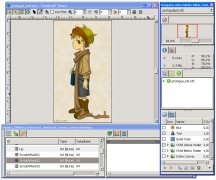Synfig Studio For Mac
Since all the elements are vector-based, you'll only have to worry about pixelation resulting from a change in resolution or size when importing images directly into the program (which is very easy to do).
This tool is compatible with several layer types: geometric, gradients, filters, transformations, and many others. All of them can be handled from the program's interface; that said, more advanced users will be best able to take advantage of all the features offered.
Synfig Studio is a very comprehensive application that comes with an online user manual (found on the developer's website). Use it (with a dose of patience) to create your very own animations.
| Original author(s) | Robert Quattlebaum |
|---|---|
| Stable release | |
| Repository | |
| Written in | C++ (using gtkmm) |
| Operating system | Linux, Mac OS X, Windows |
| Type | Vector graphics editor, computer animation |
| License | GPL |
| Website | synfig.org |
Synfig Studio (also known as Synfig) is a free and open-sourcevector-based 2Danimation software.[2] It is created by Robert Quattlebaum[3] with additional contributions by Adrian Bentley.
- Synfig Studio creates vector based animations and multimedia files. Is free and available to install on all major operating systems. Layers are generated dynamically, supports math calculations, includes tools for drawing. Supports gradients and paths, add effects, filters, distorsions such and organize layers.
- Description Synfig Studio is a free, Open Source 2D vector and timeline-based animation application. You can use Synfig Studio to create feature-film-quality animation, web animations and advertisements.
- Synfig Studio is among the best 2D vector-based animation software that’s compatible with Windows 10, 8, & 7 (64 bit & 32 bit), mac OS X, and Linux 64 bit. Key features of Synfig Studio Synfig Studio is released under the General Public License (GNU) GPL v3, and therefore, it’s free to download and use for personal or business purpose.
Layers and Filters. Synfig provides 50+ layers to create artwork and animation of any complexity. Choose from various layer types: geometric, gradients, filters, distortions, transformations, fractals and others.
Synfig began as the custom animation platform for Voria Studios (now defunct[4]), and in 2005 was released as free/open source software, under the GNU General Public License.[5]
Features[edit]
As a true front-end and back-end application, it is possible to design the animation in the front-end, Synfig Studio, and to render it at a later time with the backend, Synfig Tool, on another (potentially faster) computer without a graphical display connected. Incremental and parallel rendering with Synfig Tool is supported by some open source render farm management software, such as RenderChan.
The goal of the developers is to create a program that is capable of producing 'feature-film quality animation with fewer people and resources.'[6] The program offers an alternative to manual tweening so that the animator does not have to draw each and every frame.[7]
The software is capable of simulating soft-shading using curved gradients within an area so that the animator doesn't have to draw shading into every single frame. There is also a wide variety of other real-time effects that can be applied to layers or groups of layers like radial blurs, color tweaks that all are resolution-independent. Other features include the ability to control and animate the width of lines at their individual control points, and the ability to link any related data from one object to another. Synfig also works with High Dynamic Range Imaging.
File formats[edit]
Synfig stores its animations in its own XML file format, often compressed with gzip. These files use the filename extension .sif (uncompressed), .sifz (compressed) or .sfg (zip container format). The files store vector graphics data, embed or reference external bitmap images, and also a revision history of the project.
Synfig can render to video formats such as AVI, Theora and MPEG, as well as animated graphics formats such as MNG and GIF. It can also render to a sequence of numbered image files, using formats such as PNG, BMP, PPM and OpenEXR.
From version 0.62.00, Synfig has basic support for SVG import.[8]
From version 0.91 Inkscape can save as .sif file format.

Uses[edit]
Since May 2008, a group of Russian volunteers have been trying to make an animation movie project called the Morevna Project using Synfig, based on the folk-tale of Marya Morevna re-invented as a science fictionanime. They have been making regular updates since then on the Morevna project site, including a demo video released on November 10, 2012.[9]Free Software Magazine contained an article on the project.[10]
Name[edit]
Synfig Studio Review
It was originally called SINFG, a recursive acronym for 'SINFG Is Not A Fractal Generator', referring to the software's capability of generating fractal imagery in addition to animation.[11]
Is Synfig Studio Safe
See also[edit]
References[edit]
- ^'synfig.org Competitive Analysis, Marketing Mix and Traffic - Alexa'. www.alexa.com. Retrieved 2020-09-18.
- ^'Overview - Synfig Animation Studio'. wiki.synfig.org. Retrieved 2020-09-18.
- ^'Interview with Synfig's Robert Quattlebaum'.
- ^'Voria Studios Closing Letter'.
- ^'Synfig Open-Source Announcement'.
- ^'Synfig Studio :: Home'.
- ^Bowen, Ronda (13 March 2011). 'Top 5 Low-Budget and Free Flash Editors'. Brighthub.com. Bright Hub Inc. Retrieved 7 February 2015.
- ^'Synfig 0.62.00 Release'. Archived from the original on 2010-05-25.
- ^'Morevnaproject.org'.
- ^'The Morevna Project: Anime with Synfig and Blender'. Archived from the original on 2011-08-14.
- ^'Synfig Studio :: History'.
External links[edit]
- Official website
Motion graphics and animation software | ||||
|---|---|---|---|---|
| 2D | 3D | Mix | ||
| Free and open-source | ||||
| Closed-source | Freeware |
| ||
| Commercial | ||||
| Discontinued / Legacy | ||||
Synfig Studio Free Download
